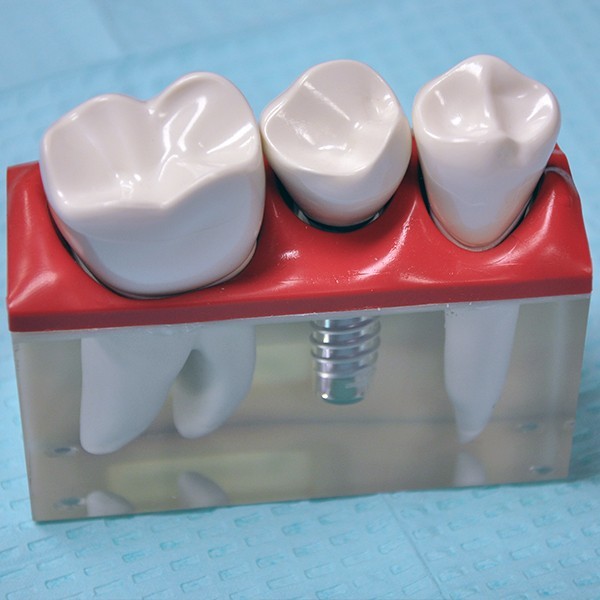Periodontics & Implantology Blog
How Orthodontics Affect Dental Implants
Many people are choosing to undergo orthodontic work as adults, and a natural byproduct is that they are being given the complicated task of figuring out how to navigate the relationship between orthodontics and dental implants. So, are implants compatible with orthodontic work? The answer is... sometimes. It’s all up to your unique situation. We here at San Antonio Periodontics and Dental Implants want to help guide you in all of your dental endeavors, so we’re giving you some general best practices when it comes to navigating complex task of mixing orthodontics and dental implants.
What are Dental Implants?
Before we even discuss combining implants with orthodontics, it’s important that you know what exactly a dental implant is. In many ways, they’re very similar to natural teeth, but where they differ makes all the difference when it comes to orthodontic treatment. Dental implants are titanium screws that are inserted into the jaw in the place of a missing tooth. Once an implant is placed, a prosthetic crown is attached. These crowns are, in many ways, indistinguishable from your other teeth — you might even forget that they’re there at times! Really, it’s what lies beneath the implant crown that matters when it comes to orthodontic care. Because the implant is screwed into the jaw, it is immovable, which is usually a great thing. However, because implants lack the ligaments that allow for movement in natural teeth, they can cause some problems when it comes to adding in orthodontic work. So, what can you do if you need a dental implant but you also need braces?
The gist of it...
In general, if you need both implants and orthodontic work, it is usually advisable to have braces fitted before getting a dental implant if possible. Like we just discussed, though dental implants appear and generally function the same as natural teeth, they are rooted more firmly into the jaw. Once an implant is placed, it can’t be moved by braces. In fact, orthodontics can even be used to make it easier to place an implant in the future; braces can be used to create space between teeth or even to move the roots of neighboring teeth into the optimum position for safe and easy implant placement. And if you want to get an implant in the future, braces can be used to keep space reserved. But what if you already have a dental implant, need to get an implant before braces, don’t want an implant at all, etc. We’ll address all of that and more in the next few sections. Keep reading to have all of your questions answered!
If you already have a dental implant
There are times where a patient either already has a dental implant or it makes more sense to place an implant before going forward with orthodontic treatment. In both cases, there are options. If the teeth around an implant site aren’t targeted for orthodontic treatment, it’s usually safe to go ahead with placing an implant before applying braces.
Additionally, if you already have an implant, it may start to look a little out of place as you age and your teeth naturally begin to push toward the front of your mouth. As your teeth crowd toward the front, your implant will remain immovable, remaining in its rightful place in your mouth. If this happens to you, braces can be used to correct the issue, moving the teeth around the implant until they are back in their rightful place.
Implants can even be placed to aid in orthodontic treatment! As we mentioned earlier, implants are immovable, and while that can sometimes present challenges to orthodontic care, that isn’t always the case. Implants can be used as anchors for orthodontic appliances. In order to do this, an orthodontist would fit an orthodontic appliance to the screw of an implant, using it to anchor other orthodontic appliances, and then replace it with a natural crown once treatment has been completed. There are even implants that are specifically designed for orthodontic treatments. Temporary Anchorage Devices (TADs) are small implants that are temporarily placed shallowly into the jaw and used as anchors to make orthodontic work move quicker. TADs are a great alternative for wearing headgear — who wouldn’t want to avoid that — and are only temporary, as the name suggests. Once treatment is over TADs are removed, leaving your mouth good as new!
If you don’t want a dental implant
What if you want to eliminate the need for a dental implant altogether? In some cases, orthodontic work can do just that! It is sometimes possible for orthodontists to use braces to close the gap created by a missing tooth. However, this isn’t always possible and it is best to discuss this option with your dentist so that they can assess your options based on your unique situation.
So there you have it! We wouldn’t say that implants and orthodontics are necessarily compatible, but there’s definitely some wiggle room for the two to work together at times. Our best advice: speak with your dentist, orthodontist or periodontist if you are trying to figure out how to combine an implant with orthodontic treatment. In fact, we here at San Antonio Periodontics and Implants are available and ready to help! Just fill out an appointment request form and we’ll contact you to set up a consultation. Our dedicated team knows how to navigate these difficult decisions, and we’re eager to help you in any way that we can.
When you subscribe to the blog, we will send you an e-mail when there are new updates on the site so you wouldn't miss them.
Our professional and gentle treatment of gum disease, cosmetic procedures and dental implants is personalized.




